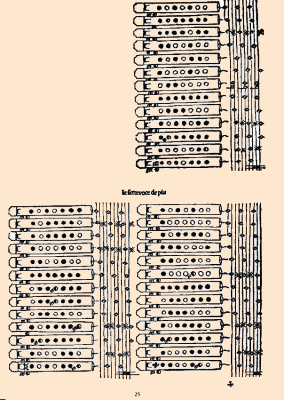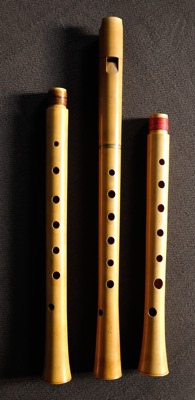PHILIPPE BOLTON
HANDMADE RECORDERS & FLAGEOLETS
THE "GANASSI RECORDER"

© KHM |
The "Ganassi" recorder came into fashion during the last twenty or thirty years of the XXth century. It was the result of both musicians' and instrument makers' speculations on the instrument that could use the high note fingerings given in Silvestro Ganassi's treatise, La Fontegara, published in 1535. The instrument that became the main object of these speculations is today in the Kunsthistorisches Museum in Vienna, an alto in g, made from boxwood, tuned to a=466 Hz, with a nearly cylindrical bore that flares out at the bell, and unusually large finger holes. It is no longer in good playing condition. It may be on account of these somewhat unusual features that some makers thought that it might be the missing link leading to Ganassi's fingering charts, and with a few modifications to the design an instrument was made that could play a range of more than two octaves with fingerings similar to those of La Fontegara. |
It was then generally thought that this recorder n° SAM 135 was a solo instrument made specially to play over a larger range of most of the other recorders of its time using the high note fingerings shown in these charts.
This is probably how the so called "Ganassi recorder" came into being. Since it was the first solo recorder to arrive on the market with a different sound quality from that of baroque instruments, it was very quickly
adopted as being the ideal instrument for playing all the pre-baroque repertoire. Many makers soon started to build it.
Its cylindrical bore enables the construction of one or more extra lower joints at different pitches, each with its own specific tone colour.
The term "after Ganassi" often used when referring to this instrument is incorrect, since Silvestro Ganassi was a musician and probably never made any instruments.
New information has been brought to light in the last few years about the original SAM 135 recorder.
- Its range is no wider than that of other consort instruments of the time, an octave and a sixth. This has been verified on the instrument itself, and also confirmed on exact copies built by some makers.
- There is a case for a consort of recorders in the museum made of several wooden tubes,bearing the same maker's mark as that on the instrument, in which it fits perfectly. This would suggest that it was just part of a set of recorders and not meant for solo playing.
- Close examination of Ganassi's high note charts shows differences that would lead us to believe that there is no real system behind them, but that they are simply the result of the author's experiments on three of his instruments from different makers. For more information on this point click here or on the reproduction of the charts above.
With regard to the sound quality, the spectrum produced by a cylindrical bore is not quite the same as that from the choke bore typical of later recorders which is richer in harmonics. The use of this type of instrument could therefore give a different tone colour to that which 17th composers of the 17th century might have had in mind.
Au delà de 1550 aucun traité ne mentionne les notes aiguës de Ganassi, ce qui signifie sans doute qu'elles n'étaient simplement pas employées.
Le changement est amorcé en 1556 avec L'Epitome Musical de Philibert Jambe de Fer et sa tablature couvrant une tessiture de 2 octaves avec l'utilisation du troisième partiel pour les notes les plus aiguës et par conséquent des mouvements de doigts beaucoup plus ergonomiques, proches de ceux que nous utilisons aujourd'hui.
A quelques différences près nous retouvons les mêmes chez Mersenne et chez Blankenburgh (der Fluyten Lust Hof) au XVIIe siècle.
After 1550 no treatices indicate Ganassi's high notes which would probably have been obsolete by then. The first sign of a change came with Philibert Jambe de Fer's L'Epitome Musical (1556) whose chart covers a range of two octaves using the third harmonic at the
top of the second octave giving easier finger movements. In the XVIIth century Mersennes and Blankenburgh (Der Fluyten Lust Hof), indicate similar fingerings which had probably become standard for solo instruments by that time.
Renaissance consort recorders being tuned a fifth apart the "Ganassi soprano" (or descant) in c would probably not have existed at the time, would probably have been made to play in d.

